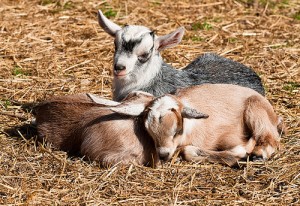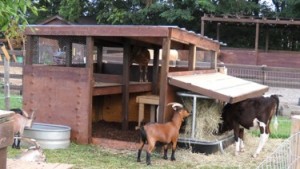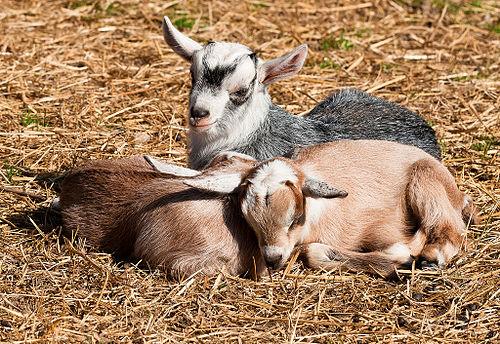 So you have caught a case of goat fever?
So you have caught a case of goat fever?
Perhaps you have done extensive, meticulous research about goats and have come to the conclusion that Capra aegagrus hircus would be a welcome addition to your farm…or perhaps you were noodling about the local farmers’ market, poking the cabbages and admiring the jars of fresh local honey, when you were taken in by a pair of friendly, intelligent, liquid brown eyes with horizontal pupils peering out at you from a slatted crate in the back of an old pickup.
In any case, it is easy to understand the appeal of goats, as they are one of the oldest domestic animals known to man. These clever ruminants have been a part of human lives and livelihoods for over ten thousand years. Smart, social, productive, and hardy, the goat is enjoying a renewed popularity in the United States as more and more families discover the joy of small-scale farming.
Goats 101
When properly kept, goats are a wonderful addition to the small farm or homestead: they can produce milk and high-quality fertilizer, and, if so desired, meat and hide as well. Unlike their fellow farm animal the bovine, they are small and easier to handle for the novice. Goats require less land and/or resources to raise. And perhaps most desirable considering the busy lives most people have today, it is unnecessary to adhere to the strict schedule the milk cow often requires. Goats are browsers more than grazers, and they have a delightful appetite for the rougher brush, poison ivy, fallen leaves, and other less palatable forage, making them a popular natural method to clear property. When pastured with cows or other livestock, they can provide a good control for undesirable overgrowth in your pasture.
Goats are also clever climbers, impressive high jumpers, and talented escape artists. They have a proclivity for noshing on your landscaping (or your neighbor’s, as a goat has little regard for property lines) as well as wooden structures and farm equipment if within reach. They can be shockingly destructive in a relatively short period of time, so proper housing is essential to ensure both the health and safety of your animals and your peace of mind. An only goat is not a particularly happy animal, so plan for at least two if you can, or at minimum, another companion of like species.
There are over 300 breeds of goats from the diminutive pet pigmy to the impressive multipurpose Boer. The size of your property and your planned use of the goats will help determine which breed fits your needs, but for the most part, housing, feeding, and general care are the same with only moderate adjustments in scale. There is a plethora of excellent books that delve into the minutia of goat care and design of a goat house. It may seem intimidating, but the first-time goat owner can feel confident that good common sense and a basic knowledge of these sturdy animals’ needs and proper general care will result in a successful and rewarding goat keeping experience.
Housing
The hair of the goat is hollow, which means as a rule they regulate their temperature quite well and are hardy in even the colder climates. As with any species of livestock, they do need protection from the elements. Goats seem particularly sensitive to exposure to drastic changes in weather. Even if you’ve got acres of rolling hills on which your animals can wander, a shelter of some kind is a necessity and a small pen enclosure highly recommended when it comes to kidding, illness, grooming, breeding, milking, or general health care. A proper fence is also critical, be it a small lot or several acres.
A cold goat is not a happy goat and a wet goat rather miserable, but a cold, wet goat is an open invitation to pneumonia. Conversely, an animal without access to a shady, cool area in hot temperatures is susceptible to heat injury and dehydration, which can lead to serious problems, particularly in bucks and wethers. In locations with more moderate seasons, a three-sided shed with a roof open to the west, furnished with a few narrow benches, might be just the ticket, while goats who spend days on end with temperatures in the teens would be more comfortable in a solid enclosure that can be closed up somewhat and perhaps insulated with bales of straw.
Goat owners seem to have come up with remarkably diverse and clever ways to provide housing for their goats— converted barns, old hen houses, and even large plastic dog crates and giant cement drainage pipes have been pressed into use to house goats. While many of these methods work out well for the savvy farmer, certain things must be taken into consideration. Cement is wonderful in many respects, as it is chew proof and easy to clean, but it can retain moisture and dampness. Plastic is very tempting for goats to chew on and can be stifling hot in the summer and, unless insulated, retains little heat in the winter. For the first-time goat owner without a suitable barn or shed, buying a prebuilt wooden shed might be the easiest route, but rather costly. Building a basic goat house out of wood is a good choice. (That might seem in contrast with the statement above about the potential for chewing. However, careful planning, some well-placed protection, and a good varied diet for your animals should reduce that sort of issue.)
New manual shows you the joy of keeping goats…
A rule of thumb, given to some adjustment depending on the breed of goat you plan to house, is between twelve to sixteen square feet per animal in the goat house. A smaller foot print might lead to crowding and weaker herd members being pushed out, while larger spaces are harder for the goats to keep warm in the winter months.
Thanks to the modern hardware store and the uniform size availability of most building materials, even the novice goat owner with limited carpentry skills and basic tools (and a bit of help holding materials in place) can build a simple, attractive, functional goat house. A thoughtful design can work well in areas of excessive heat and can be modified for locations with cold winters.
 This shed, a surprisingly simple and easy-to-build design of sixty-four square feet, can accommodate up to four average-size goats (and one wayward calf, it would seem). It provides a breezy opening along the top of the walls for good circulation. It features a raised platform on one side for climbing, napping, grooming, and milking if desired, and a cozy spot underneath the platform that is shady in the summer and blocked from the wind in the winter.
This shed, a surprisingly simple and easy-to-build design of sixty-four square feet, can accommodate up to four average-size goats (and one wayward calf, it would seem). It provides a breezy opening along the top of the walls for good circulation. It features a raised platform on one side for climbing, napping, grooming, and milking if desired, and a cozy spot underneath the platform that is shady in the summer and blocked from the wind in the winter.
A simple door can be fashioned, as well as shutters for cold and snowy climates or to secure other animals outside when handling an individual goat. The most tempting wood edges can be wrapped with chicken or welding wire, which will discourage your goats (who only have teeth on top) from excessive nibbling. If you plan to rake up and use droppings in your garden, a dirt floor does nicely. It is easy to keep clean, provides few spots for rats and other “nasties” to set up housekeeping, and stays cooler in the summer. A sprinkling of clean straw or natural wood shavings such as pine can provide a bedding if desired, particularly in winter, and add a bit of organic material to your home-grown fertilizer. (Be leery of waste wood chips unless they are your own, as some common landscaping bushes are toxic to goats.) Straw in particular works well, gently lifted and tossed with a stall fork into a pile in the corner, and it is quick work to sweep up the pellets that have sifted through with a broom and dustpan. If you add lighting or any other electrical wires, be very, very careful to secure the wires well out of goat range and keep light fittings well protected.
The Yard
If you are building a yard in which to pen your goats, try to plan a generous 200 feet per goat, particularly if they are going to be contained all or a majority of the time. Keep in mind that a nice grassy lot will be quickly reduced to mostly dirt. Generally, goats’ nibbling alone would simply keep the grass short (they do not pull up grass by the roots like equines do, so they normally do not denude an area by eating alone unless it is a substantial number of goats on a small area); however, walking, running, playing, and scratching at the ground to make it “comfy” can quickly turn the area into a dry lot. Trees or bushes inside the enclosure to provide shade are desirable but must be well protected if you plan for them to remain! Your yard has a strong likelihood of becoming muddy and churned up during the wetter seasons, so a gravel path of small smooth stones on the areas you plan to travel while taking care of the goats could make things easier. If you have only a small number of goats and a modest pen, you might try to protect the grassy footing with a layer of chicken wire, laid flat over the grass while it is mowed very short, and tacked down firmly and safely. The grass will grow up through the fence but the wire will provide a bit of protection for the root base. However, careful inspection to make sure a curious goat has not pulled up a corner and created a hazard is important, and raking up droppings for garden use is more difficult.
Fence is critical. Well-placed posts should be no more than eight feet apart, and tightly attached woven “no climb” welded field wire is a good choice at a minimum height of four feet. Consider taller if you are housing larger breeds. Be aware that for some reason goats seem to be in a perpetual state of “itchiness” and will bend wire up by rubbing along the length, often creating a gap along the bottom for an escape. To discourage climbing, rubbing, and prodding with horns (if your goat indeed does have horns), a line of hot fence at chest level works quite well. While many solar devices seem to still be working out kinks in performance, the solar fence charger has been around for many years and, when properly grounded and well maintained, works quite well in areas without power available. Chose a gate that has the bars appropriately spaced for your size animal— not too wide to allow squeezing through and not too narrow to allow a head, particularly with horns, to become trapped. If you are unsure if your gate presents a head catching hazard, a length of the field wire firmly attached to the outside of the gate can give you some piece of mind. The more narrow the gate you can get away with and still accommodate any equipment, the better, asgoats get quite good at the “fast break” when you are coming in and out!
The same holds true if you plan to provide a hayrack for your goats for feeding forage. Pay particular attention to the width of the bars. Several companies do in fact make hayracks for goats, which are smaller and better spaced. A covered roof that can be lifted up is a big plus if you are feeding forage outside of the barn or shed. Goats make quite a mess with hay and other fed browsing materials, which can lead to mold as well as rats and mice setting up housekeeping. For all the reputation goats have for eating anything, it is remarkable how quality roughage immediately becomes “unpalatable” in some goats’ minds once pulled on the ground and trodden upon or slept on!
Water
Goats need fresh clean water, and they can be remarkably picky about a water source. You need a tank big enough to provide water for your herd and not get turned over by playfulness but small enough for you empty and clean regularly. Plan to raise your tank to a level that allows easy drinking but discourages accidental droppings or tumbling in for young goats. A raised or tall tank can be surrounded by a couple of solid cinder blocks; goats will quickly learn to climb up on a “step” to get a drink. Surprisingly, water is the biggest challenge both in the summer and winter months. Insulated tanks are pricey but can be a good investment in extreme climates; a quick Internet search can find several “home” insulation designs that look quite promising. In the long hot summer months that seem to turn a clear tank a mucky green overnight, sometimes a small pond pump, solar or electric, placed on the bottom of the tank will keep it circulating and more cool and clear; as a rule, goats are not given to go diving, but take care that the water level stays high enough to keep curious lips off of both the pump and the wires.
Safe, well-designed housing of your animals make take some extra time, thought, and expense, but will be well worth it in the long run for both your family and your herd. Welcome to world of goats—they can be very rewarding and a great joy to have on your farm.
©2012 Off the Grid News










